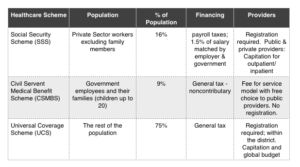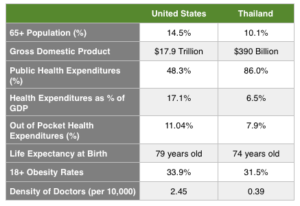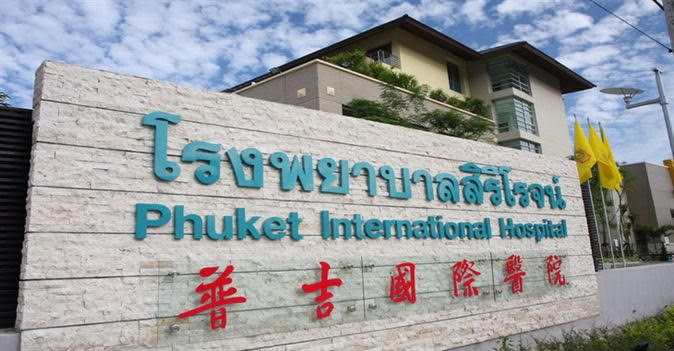 In a recent trip to Thailand, I was amazed by the beauty and peacefulness of the country. When I first landed, the Thai people that greeted me in the airports and taxis quickly told me they were known as the Land of Smiles. However, it was not until I fully immersed myself into the daily city life of Chiang Mai, Bangkok, and Phuket, that I fully understood what they meant. Everyone I met was cordial and polite with a lightness about them. Many were Buddhists with a high regard for nature and the environment. It struck me how comfortable they were with the world around them. Since there is a strong belief in reincarnation, it seemed there was less of a burden living like you only have one chance to get it right. That spirit permeates throughout the country and allows for a carefree atmosphere wherever you go.
In a recent trip to Thailand, I was amazed by the beauty and peacefulness of the country. When I first landed, the Thai people that greeted me in the airports and taxis quickly told me they were known as the Land of Smiles. However, it was not until I fully immersed myself into the daily city life of Chiang Mai, Bangkok, and Phuket, that I fully understood what they meant. Everyone I met was cordial and polite with a lightness about them. Many were Buddhists with a high regard for nature and the environment. It struck me how comfortable they were with the world around them. Since there is a strong belief in reincarnation, it seemed there was less of a burden living like you only have one chance to get it right. That spirit permeates throughout the country and allows for a carefree atmosphere wherever you go.
About Thailand
With over 67 million people and a $390 billion GDP (based on 2016 IMF estimates), Thailand ranks 28th out of 191 countries in economic wealth. Their healthcare system also ranks fairly high at 47th out of 191 countries based on the 2000 World Health Organization (WHO) report on healthcare systems. In comparison, the United States ranks #1 in GDP with a healthcare system ranked at #37. The WHO calculates healthcare rankings by analyzing how countries balance both the quality and equity of the healthcare services provided against the efficiency of its delivery.
For the past 14 years, Thailand has been able to do what the United States has not, despite the passing of the Affordable Care Act. Since 2002, Thailand has offered affordable, high quality healthcare universally across the entire country.
Offering universal healthcare coverage was no small task. The Thai people are very diverse. Among the largest minorities living in the country are ethnic Lao (25%), ethnic Khon Muang (10%) and many others from the neighboring countries of Burmese, Cambodians, and India. The population is growing as well; 0.3% annually with net migration of 100,000 people per year. To make things harder, a little more than half of the country lives in urban areas leaving the other half in much harder to reach rural and mountainous areas. Developed nations that have been able to provide universal healthcare usually have homogenous populations, which make it much easier to deliver healthcare services to the entire population.
So How Did They Do It?
It starts with a country’s constitution. If it is not part of the moral fabric of the country, universal healthcare will never become a reality.
The right of every Thai citizen to access health care and the right of the poor to free health care were addressed in the 1997 and 2007 constitutions, and access to health services for all was part of the 8th National Social and Economic Development Plan (1997-2001). – Thailand’s Universal Coverage Scheme: Achievements and Challenges.
Thailand achieved universal health care in 2002 after decades of trial and error. Prior to the change, more than 30% of the country lacked coverage. The Universal Coverage Scheme (UCS) was credited with covering 75% of the country. This included 18 million people previously uninsured. The remaining 25% received their coverage as either a government employee or private-sector employee. In comparison, close to half of the United States receives healthcare coverage from their employer; a much higher percentage than Thailand. Additionally, only 15% of the U.S. was uninsured before the Affordable Care Act passed; roughly 45 million people. However, after 3 years of the law in the U.S., only 20 million people have received coverage. That means Thailand was able to enroll as many people in one year it has taken the United States to enroll in 4 years of Healthcare reform.
In the 10 years since the UCS was enacted, the Thai healthcare system continues to be successful. Lower income people have greater access to care. This has been seen with increased outpatient and hospital visits by the poor. Additionally, the rate of those who became poor due to healthcare expenses declined radically from 2.71% in 2000 to 0.49% in 2009. Lastly, customer and physician satisfaction rates are up to 90% and 79% respectively.
Financing Universal Healthcare
Federal funds finance the UCS at a high enough level to ensure healthcare services are free of charge to those that need it the most. The benefits offered under the plan focus on preventive care, health promotion, and disease prevention. There is also a fixed budget with caps on physician payments, which help to control costs. The biggest change in the reform was the focus on primary care. Specifically, the UCS ensures that the Thai people visit their primary care physician who then coordinates their health care through the healthcare continuum. Additionally, Thailand already had a strong healthcare infrastructure as a foundation. Physicians receive capitation and case-based payments with a global health budget. That is, they received a fixed amount of money at a local level to take care of the healthcare needs of the population they serve within their district.
Under this new healthcare model, the “near poor” who struggled the most now have a pathway to affordable care. Out of pocket health care costs used to account for 33% of total costs. This has now declined to less than 8%.
Roughly 47 million people receive their coverage through the UCS. With more people accessing coverage, healthcare costs grew by more than 71% from 2002 to 2011. That was an increase from 1,202 baht to 2,693 baht per capita. Increased costs were mostly driven by higher labor costs for healthcare physicians and increases in utilization; people using more services every year. However, despite these increases, the Thai government works collectively to ensure the UCS remains sustainable. The constitution serves as their mission, vision, and guiding principles.
A person shall enjoy an equal right to receive standard public health services, and the indigent shall have the right to receive free medical treatment from State infirmaries. The public health service by the State shall be provided thoroughly and efficiently. The State shall promptly prevent and eradicate harmful contagious diseases for the public without charge. – The 2007 Thai Constitution
Lessons from the Land of Smiles
1. Adopt universal healthcare policies that cover a large percentage of the population. This will encourage the program’s success and sustainability. Over 75% of the country receives their healthcare coverage from the Universal Coverage Scheme compared to American where less than 10% receive their coverage from the Affordable Care Act’s Health Insurance Marketplaces.

2. Invest in the poor across all areas of their lives, not just healthcare. Thailand has learned that helping the poor will consequently improve the economics of the entire nation. They have consistently invested in the social fabric of their country seen by their high literacy rates, very low unemployment rates, and the lowest food deficit rates in the region. All these factors assist with eliminating the barriers caused by socioeconomic factors.
3. Focus on health promotion and healthcare prevention. Thailand has been able to emphasize the role of primary health care and the rational use of effective and efficient integrated services. Thailand also ensures proper referrals to high quality hospitals. Lastly, the county has eliminated any of the out of pocket expenses for preventive care.

